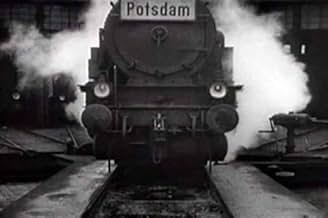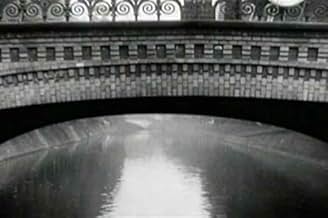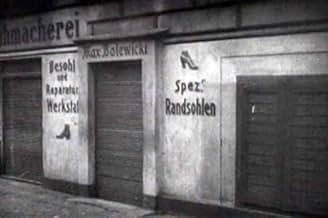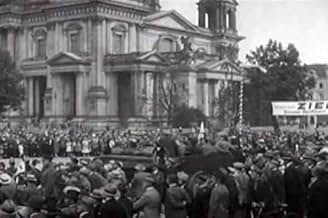IMDb-BEWERTUNG
7,6/10
5041
IHRE BEWERTUNG
Dieser Film zeigt uns einen Tag in Berlin: den Rhythmus der Zeit, vom frühen Morgen bis in die tiefe Nacht.Dieser Film zeigt uns einen Tag in Berlin: den Rhythmus der Zeit, vom frühen Morgen bis in die tiefe Nacht.Dieser Film zeigt uns einen Tag in Berlin: den Rhythmus der Zeit, vom frühen Morgen bis in die tiefe Nacht.
- Regie
- Drehbuch
- Hauptbesetzung
Paul von Hindenburg
- Self
- (Nicht genannt)
Empfohlene Bewertungen
Berlin, Symphony of a City is a remarkable historical document of the mighty city before its Wagnerian capitulation within less than twenty years of its filming. Along with Paris, Berlin was the epicenter of a Europe emerging from World War 1 into the Roaring Twenties and director Walter Ruttman for the most part captures the energy and pace of the 20th century metropolis.
Moving from morning to night Symphony emphasizes the cities industrial muscle but also divides evenly portraits of the have and have nots of Berlin, the grime as well as the glitter. It is a city on the move and move it does from the crowded sidewalks to the congested avenues and its varied populace . It is in the faces of these Berliners that the film holds its greatest fascination for me watching children playing and youth sporting events with the knowledge that most of them will be of draft age for the oncoming conflagration that will reduce this city to rubble.
The documentary does have problems with some scenes clearly staged (in one case a suicide filmed in close-up) and a roller coaster scene is overlong but overall when put into historical context this is a valuable visual document of a city that is extinct as Atlantis.
Moving from morning to night Symphony emphasizes the cities industrial muscle but also divides evenly portraits of the have and have nots of Berlin, the grime as well as the glitter. It is a city on the move and move it does from the crowded sidewalks to the congested avenues and its varied populace . It is in the faces of these Berliners that the film holds its greatest fascination for me watching children playing and youth sporting events with the knowledge that most of them will be of draft age for the oncoming conflagration that will reduce this city to rubble.
The documentary does have problems with some scenes clearly staged (in one case a suicide filmed in close-up) and a roller coaster scene is overlong but overall when put into historical context this is a valuable visual document of a city that is extinct as Atlantis.
This is a very straightforward and pleasant silent picture that delivers exactly what it promises. Namely: footage of Berlin, its residents, and the whole spectrum of city activities during an ordinary day in 1927. If you have any interest in seeing real life in Weimar Germany, this film is an excellent rental. It opens with an Eisensteinian-style montage sequence, as a train approaches the city. Upon its arrival in Berlin's Union Station, the city is remarkably desolate. As the film progresses, the city begins to wake up, and you are shown residents at work (mostly in factories) and leisure. You will see shopkeepers, businessmen, restauranteurs, policemen, soldiers, politicians; children at play and even some vagrants. The acts become gradually more harsh as the film progresses, with mildly unpleasant imagery beginning to creep in (e.g. shots of dogs fighting, footage of beggars, litter, an arrest, etc.), only to gracefully recede as the film reaches its closing. The final act shows Berlin's night life, which is as lavish and swinging as anything in our own "Roaring 20's." This is an impeccable time capsule and it has something to offer both film and history buffs. Berlin was truly a world city at this time, and it was extremely interesting to see everything in the Weimar's Golden period, before Hitler and the destruction that followed. Technically speaking, it is a very well made and restored film; the footage is crisp and the music was never overwhelming. This is a really easy film to appreciate and it is definitely worthwhile, particularly for history buffs. Highly recommended. ---|--- Reviews by Flak Magnet
This is a silent era documentary showing a day in the life of Berlin starting from the morning to the late night. It shows people and places in their day to day existence. It's artistic like showing the machinery at work. It's fascinating to see people in their everyday lives. It's amazing to see the places especially since most of them were destroyed in WWII. It's great to see living lives in this time era. This is a world in between the two Great Wars. The economic crash has yet to happen. It's a Germany which still functions with its old wealth and new technology. It's a working city. It's a great time capsule and a terrific movie by itself.
An amazing work of the 'slice of life' films of the 20s, really the main and most admirable example along with Dziga vertov's Man With the Movie Camera, to this day, the film remains an effective portrayal of the great city that Berlin was even back when the film was made. In fact, as time goes by, it picks up even greater importance because of the historical value that it holds.
What is truly admirable is the editing and the cinematography. Perhaps even more than the things that are contained in the framework, is the framework itself which has the first impact on the viewer. The wonderful photography, and the skilled editing that is able to go from man to machine, from trains to horses, from workmen to roller-coaster rids, are always elegant and original, even in regards to Vertov's later work mentioned above. It is, in fact, stylistically a Ruttmann work. Although the work of Vertov and Ruttmann are similar, there is a difference in the sense that while The man With the Movie Camera is aware of being a film, and plays with the process of film-making, Berlin actually lets the contents of the framework play out, and never quite interferes with it.
What is truly admirable is the editing and the cinematography. Perhaps even more than the things that are contained in the framework, is the framework itself which has the first impact on the viewer. The wonderful photography, and the skilled editing that is able to go from man to machine, from trains to horses, from workmen to roller-coaster rids, are always elegant and original, even in regards to Vertov's later work mentioned above. It is, in fact, stylistically a Ruttmann work. Although the work of Vertov and Ruttmann are similar, there is a difference in the sense that while The man With the Movie Camera is aware of being a film, and plays with the process of film-making, Berlin actually lets the contents of the framework play out, and never quite interferes with it.
Berlin: City Symphony is one of those early experiments in montage - early as in before sound was invented and right after Battleship Potemkin changed everything. It's not always montage, as some might believe from its recommendations (i.e. Koyannasquati), as the director Walter Ruttmann is making documentary as much as city-scape. It's about a full day and night among the dwellers and the objects of a city: the moving trains, the people shuffling by about their various concerns, and the people at jobs and things like a factory at work and phones being answered used for editing fodder.
Some of this is dazzling work, cut and speed up to reflect a mood of a city that is vibrant and hectic, imaginative and crazy, and sometimes tending for the dramatic. Ruttmann also has a rather weird design with the pacing at times; a woman in one 'scene' looks over a river, and in a state of sorrow falls over. People rush over to see what has happened, and we see a shot of the water and the woman gone under... and then it cuts right away to a beauty pageant! It throws a viewer off to see Ruttmann's unconventional choices, and how images flow together like the racers (cars, horses, people, boxcars), and there develops a simple but engrossing poetry of people as "actors" in front of a camera on their daily travels or having fun like at the funshow in the auditorium. It's not always as exciting or delirious as a Russian counterpart like Man with a Movie Camera or Kino Eye, but it pays loving tribute to its city at its time and place, showing the light with the dark, the commonplace with the unusual.
Some of this is dazzling work, cut and speed up to reflect a mood of a city that is vibrant and hectic, imaginative and crazy, and sometimes tending for the dramatic. Ruttmann also has a rather weird design with the pacing at times; a woman in one 'scene' looks over a river, and in a state of sorrow falls over. People rush over to see what has happened, and we see a shot of the water and the woman gone under... and then it cuts right away to a beauty pageant! It throws a viewer off to see Ruttmann's unconventional choices, and how images flow together like the racers (cars, horses, people, boxcars), and there develops a simple but engrossing poetry of people as "actors" in front of a camera on their daily travels or having fun like at the funshow in the auditorium. It's not always as exciting or delirious as a Russian counterpart like Man with a Movie Camera or Kino Eye, but it pays loving tribute to its city at its time and place, showing the light with the dark, the commonplace with the unusual.
Wusstest du schon
- WissenswertesThe shooting was done over 18 months though the resulting feature gives the impression of just one day in the city.
- VerbindungenFeatured in Lulu in Berlin (1984)
Top-Auswahl
Melde dich zum Bewerten an und greife auf die Watchlist für personalisierte Empfehlungen zu.
- How long is Berlin: Symphony of Metropolis?Powered by Alexa
Details
- Erscheinungsdatum
- Herkunftsland
- Sprache
- Auch bekannt als
- Berlin: Symphony of a Metropolis
- Drehorte
- Berlin Cathedral, Mitte, Berlin, Deutschland(aka Berliner Dom)
- Produktionsfirmen
- Weitere beteiligte Unternehmen bei IMDbPro anzeigen
- Laufzeit
- 1 Std. 5 Min.(65 min)
- Farbe
- Sound-Mix
- Seitenverhältnis
- 1.33 : 1
Zu dieser Seite beitragen
Bearbeitung vorschlagen oder fehlenden Inhalt hinzufügen




















